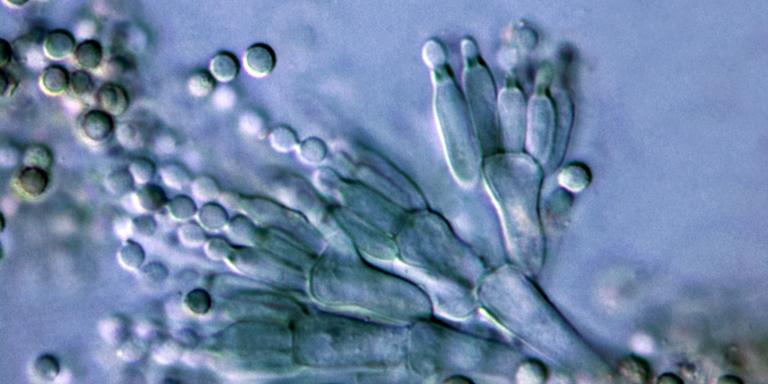Asthma
In asthma – a chronic respiratory disease – the airways are permanently inflamed and are, as a result, particularly sensitive to irritants such as allergens, leading to breathing difficulties

Table of contents:
In asthma, the airways narrow due to a variety of factors and sufferers find it hard to breathe in and out. Typical symptoms are wheezing, coughing, chest tightness and shortness of breath. Approximately one in fifteen adults and one in ten children in Switzerland suffer from the disease.
Asthma – or bronchial asthma – occurs as a result of a genetic predisposition and is exacerbated by certain environmental factors. In sufferers, the mucous membrane lining the airways is chronically inflamed, making the lower airways – more accurately, the bronchi – more sensitive to various irritants. There are a number of factors that can trigger asthma symptoms. A distinction is drawn between allergic and non-allergic triggers.
Allergens
Allergens are substances to which people have an allergic reaction, such as pollen, house dust mites and animals. Allergies are the most common cause of asthma in childhood and adolescence. They often trigger asthma in adults as well.
Asthma very often develops as a result of progression; if allergic rhinitis is not treated adequately and in time, in approx. one third of cases the symptoms spread from the upper to the lower respiratory tract, i.e., to the lungs. The risk of developing asthma is approx. three times greater in sufferers with allergic rhinitis than in healthy individuals of the same age. Conversely, many asthmatics also suffer from allergic rhinitis.
Asthma triggers
Irritants
Substances such as dust, tobacco smoke (including passive smoking), exhaust fumes, air pollution and smells irritate the airways and can cause or exacerbate symptoms.
Time of day
The lungs are subject to time-of-day variation. They often perform less well late at night and early in the morning than in the middle of the day. Asthmatics may experience greater breathing difficulties and shortness of breath at such times.
Respiratory infection
Pathogens such as viruses and bacteria can cause asthma symptoms. In infants, asthma is more commonly diagnosed in association with an infection than in connection with an allergic reaction.
Medication
Drugs that narrow the airways can exacerbate asthma symptoms. These include aspirin, non-steroid anti-inflammatory drugs (NSAIDs) such as diclofenac, ibuprofen and naproxen as well as beta-blockers.
Emotions
Stress, but also joy, fear, anger and sadness, can cause or aggravate symptoms.
Physical stress
The sudden change from a state of relaxation to one of stress in particular can narrow the airways.
Exertion asthma
Exertion asthma – or exercise-induced asthma – is triggered by physical exertion in virtually all cases. In most cases, chest tightness and coughing occur after just a few minutes of sports activity. The ambient temperature, humidity, breathing rate (hyperventilation) and the degree of exertion are often contributory factors.
Occupational asthma
In some occupations, employees are exposed to various substances that are a burden on the respiratory tract and can thus trigger or exacerbate asthma. Occupations at particular risk are bakers, cleaning staff and painters and decorators.
Symptoms
The symptoms and their intensity vary from one person to the next. They therefore range from respiratory symptoms that are always present to quite mild episodes of shortness of breath to life-threatening asthma attacks. There may also be periods that are symptom-free. The following are typical symptoms of asthma sufferers:
- coughing with and without phlegm
- wheezing
- frequent episodes of shortness of breath (also at night)
- chest tightness.
Diagnosis
The lung or allergy specialist uses different tests for the diagnosis of asthma:
- allergy test
- lung function test
- provocation test
If these tests are positive and the symptoms match, a diagnosis of asthma is very likely.
What is a lung function test? The leaflet from the Swiss Lung Association (in German) provides a summary of the test.
Treatment
There is no cure for asthma. However, if the asthma is well controlled, most asthma sufferers can lead a normal life that is largely symptom-free and can engage in any activity they wish, including sports. To achieve this, there are various measures available, involving treatment with and without drugs.
Drug treatment
Medication can ease breathing by reducing the inflammation or widening the airways. The goal is to control the asthma with the minimum medication. A step-by-step plan defines the medication to be used. The following drugs are available for use:
- bronchodilator medication (asthma inhaler)
- anti-inflammatory medication (asthma inhaler)
- biologics
- allergy-specific medication for respiratory allergies
- specific immunotherapy for respiratory allergies.
However, this medication can only be effective if it reaches the airways. This is why it is essential that the asthma spray is inhaled correctly. The Swiss Lung Association shows in its videos (in German) how this is done.
Non-drug treatment
- Be familiar with and apply breathing techniques when experiencing shortness of breath
- Perform breathing exercises (as shown by the Swiss Lung Association (in German))
- Avoid allergens that are triggers
- Complete and follow an asthma action plan using a traffic light system (asthma diary of the Swiss Lung Association (in German))
- Benefit from individual asthma guidance (in German)
- Stop smoking (service provided by the Swiss Lung Association, in German)
- Be physically active
Preventing an asthma attack
The risk of a sudden asthma attack can be reduced by regular and adequate treatment of the inflamed airways.
Tips and tricks
- A good breathing technique can help sufferers cope with physical exertion and acute shortness of breath better and without anxiety.
- It is important to inhale the asthma sprays correctly for them to be effective (see videos of the Swiss Lung Association)
- It is useful to have a regular asthma check (in German) and base your activities on the asthma action plan.
- To prevent asthma: it is essential to treat the allergy properly to avoid progression.
- Learning videos for children (in German)
And the GINA Patient Guide provides a detailed overview of asthma for all concerned.
Facts and figures
- 12% of all children and 6% of adults in Switzerland suffer from asthma.
- If untreated, a pollen allergy can lead to asthma in 30% of cases. This is known as progression.
- The risk of developing asthma is approximately three times greater in patients with allergic rhinitis than in healthy individuals of the same age.
Editors: aha! Swiss Allergy Centre in co-operation with the Scientific Advisory Board.




